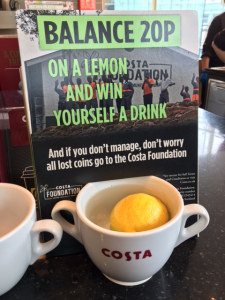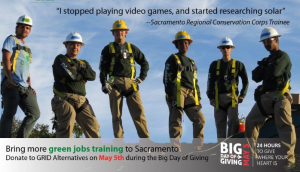On a recent trip to see my family in England, I was standing in line to buy a cup of tea in a well-known UK coffee chain, when I spotted this promotion at the register:

It stood out to me because the language and logic used is quite different than many appeals we see today. Most commonly, charitable appeals attempt to tug at the heartstrings and/or describe what your donation will mean for other people. For example:



Each one of these appeals follows a consistent idea: Your donation will make a difference in the lives of other people. By donating whatever you have, you can know it is changing things in other places.
It’s a common (and very effective) technique. It generates billions in charitable giving every year.
Side bar. For those of you who are still thinking about balancing a coin on a lemon, read one person’s tortured journey to the elusive free cup of coffee. (An internet deep dive on this also turned up this hysterical commentary from another patron on Reddit: “I successfully balanced 20p on the lemon in Costa, but nobody saw it and I was too British to draw attention to my achievement and claim my free coffee. The 20p is probably still sitting there.”)
I couldn’t find any stats on how impactful the Costa lemon campaign is, but it’s been going on for years so my guess is that they’ve been left with more than lemonade.
Why? The power of the appeal is in the language. It’s not only that the subject of this appeal is the customer instead of the person who will be the benefactor of the donation – though I’m sure that’s a factor. What stood out to me is that the language is structured in a way that it makes it very easy for the customer to take action. They don’t have to do anything more complicated than delve their hand into their pocket and find a coin to balance on a lemon. They can do it right there in line, where they have nothing better to do. They have two incentives – a free cup of coffee and/or helping people in need.
Using language that makes it easy for someone else to do the thing you want them to do is something we talk about a lot on the Javelina team – we call it “writing for action.”
Because we all live inside of our own heads, we tend to write things from our perspective. We will send someone an email telling them the full backstory of why we’re reaching out and what we want, and then be annoyed when we don’t get a response to our 5 paragraph-long rant. Or we’ll put together a beautiful event invitation describing in great detail what an amazing experience someone will have if they attend. The time, date and location are included I am sure, but too often buried under unnecessary added information.
At Javelina, when we’re producing something for a client or ourselves, we try to approach it from the point of view of “What information will propel my target audience into action?” instead of “What do I want my target audience to know?”
When you are putting together ANY kind of communication with words (or put another way – everything) that you want to result in some action or outcome, these pro tips might help you determine which words to use and in what order.
1. Take away as many barriers to action as you can.
Here’s an interesting fact. 4% of eligible people in Denmark choose to be registered as an organ donor, while in Portugal, Poland and Hungary 100% of eligible people opt for the same thing. Are Hungarians 96% more generous than their Danish counterparts? Nope. As Behavioral Economist Dan Ariely observes, the difference can be attributed to the fact that the relevant form in Denmark says something like “Check the box if you wish to be an organ donor”, while the equivalent form in Portugal, Poland and Hungary reads “Check the box if you do not want to be an organ donor.”
And so, it’s not that the Portuguese are any different from the Danish. In fact, it’s that we’re all the same – the action we are most likely to take is inaction. The option that requires less effort on our part is the thing we’re most probable to do.
Have you ever had the experience when you are held up on a project because you’re awaiting an answer to a question from someone you emailed two days ago, and have not heard back from? It can be so frustrating.
To get around this, phrase your question in a way that a non-reply means something. So it might be something like “Let me know if you have any feedback on the attached document by COB tomorrow. If I don’t hear back, I’ll move ahead with this version.”
On the Javelina team, we try to make silence mean something as often as we can. It saves time and energy for everyone involved, and the increased efficiency enables everyone to move faster.
The global lesson here is that removing as many barriers to action as possible will result in more effective communications. It can be a barrier to include too much information. Only include the vital information. Put the most important information first. Make it as easy as possible for your target audience to take action.
2. The person you’re communicating to should be the center of the world.
When you’re choosing the words to use, think not about what you want to communicate or gain from the interaction, but how you want the other person to feel. Every action is the physical expression of a feeling or emotion. Eliciting a certain feeling in someone will lead them to act a certain way.
This concept is explained very effectively by Simon Sinek in his experiment with a homeless woman’s sign. A homeless person appealing for donations, Sinek argues, is a business transaction like any other. “What the homeless are selling,” he says, “is the feeling of goodwill…and sometimes we buy it.”
By switching a New York homeless woman’s sign, Sinek helped her make more money in 2 hours than she usually would in an entire day. The old sign was similar to a typical sign you see often, talking about her homelessness, her hunger, her situation. The new sign said simply: “If you only give once a month, please think of me next time.”
As Sinek says, “Good, effective marketing is that which talks about the buyer not the seller.”
Consider that every time you communicate, it is marketing of sorts. Every time you email someone asking for them to do something, you are competing with all the other emails, social media posts, and phone calls asking that person to do something. No person can do everything, so how do you make it likely that they choose to do your thing? Like the sign about the lemon and the 20p, you make it all about them.
3. Stand out.
Often times, the first thing you have to do in order for someone to take action is to grab their attention. With a thousand things vying for our focus at any one time, the thing we do first is often the thing that stands out the most.
Whether you’re putting together a press release, a speech, a social media post or anything else designed to make others take action, think about how you can be different. Don’t follow a certain formula or format just because that’s the way it’s always done. Sure, there are circumstances where you have to follow procedure, but there are plenty of times when you don’t. Take the opportunity to do something different in order to stand out.
We’ve blogged about our Javelina job posting that yielded a record number of applications. We attribute a sizable portion of that to the fact that it was just something different.
When it comes to writing for action, small changes yield big results. Every word counts, so think about each word you are choosing and the role it plays. If it’s not playing an essential role, leave it out. Before you finalize anything you’ve written, take a step back and think “Will this compel my target audience to action?” If the answer is no, have the courage to change it until the answer is yes. Remember – small changes yield big results. And big results are what will change the world.
Across every platform. On every issue. Make Javelina part of your team.
Ready to bring your brand experience to life? Let's chat!
Javelina Consulting LLC 1026 E Keim Dr
Phoenix AZ 85014

